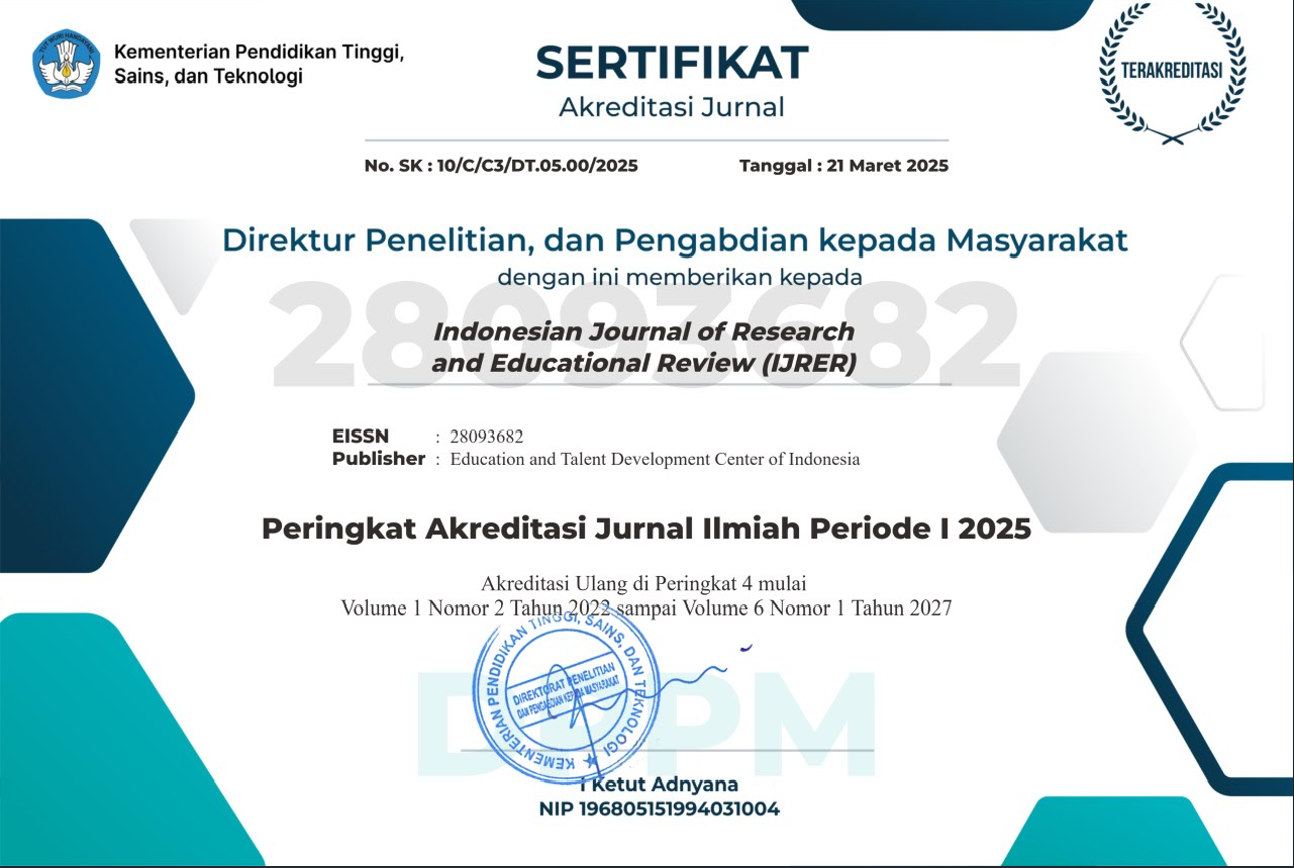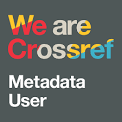The Effectiveness of the PjBL Model Assisted by Story Maps Media: The Creative Thinking Skills of High School Students
DOI:
https://doi.org/10.51574/ijrer.v4i4.3647Keywords:
Creative Thinking Skills, Disaster Mitigation, Geography, Project-Based Learning, Story MapsAbstract
Students tend to be passive in expressing new ideas or providing opinions that differ from other students when learning disaster mitigation material takes place. In addition, the learning media used are limited, such as textbooks, YouTube videos, and PowerPoints that do not fully support the development of students' creative thinking skills. Therefore, the study was conducted with the aim of determining the effectiveness of the Project Based Learning model assisted by Story Maps media on the creative thinking skills of grade XI students on disaster mitigation material. This study used a pre-experimental quantitative research type. The sample of this study was class XI E2 at Public High School 1 Purbalingga, with a total of 36 students as the experimental class. The average score of the observation sheet was 79.51%, which means that students' creative thinking skills were "good" in the project-based learning model assisted by Story Maps media on disaster mitigation material. Meanwhile, the average score of the student response questionnaire was 79.61%, so it was concluded that students "agreed" to the learning of disaster mitigation material implemented using the project-based learning model assisted by Story Maps media. This shows that the use of the project-based learning model, assisted by Story Maps media, to develop creative thinking skills in disaster mitigation material is effective in high school.
References
Andini, T. J., & Suharto, Y. (2024). Collaborative Project Based Learning Pada Mata Pelajaran Geografi: Penerapan Proyek Media Diorama 3D Untuk Meningkatkan Kemampuan Berpikir Kreatif Peserta Didik. Cetta: Jurnal Ilmu Pendidikan, 7(2), 219-233. https://doi.org/10.37329/cetta.v7i2.3291
Anugerahwati, M. (2019). Integrating the 6Cs of the 21st Century Education into the English Lesson and the School Literacy Movement in Secondary Schools. KnE Social Sciences, 3(10), 165. https://doi.org/10.18502/kss.v3i10.3898
Apriliani, Y., Nur Arif, M., Sutriyani, W., & Wakit, A. (2023). Efektifitas Model Problem Based Learning Berbantuan Media Padi (Papan Diagram) Terhadap Hasil Belajar Matematika. Jurnal Muassis Pendidikan Dasar, 2(3), 172–179. https://doi.org/10.55732/jmpd.v2i3.129
Asari, A., Purba, S., Fitri, R., Genua, V., Herlina, E. S., Wijayanto, P. A., Ma’sum, H., Ndakularak, I. L., Astridewi, S., & Sele, Y. (2023). Media pembelajaran era digital. Cv. Istana Agency.
Dada, D., Laseinde, O. T., & Tartibu, L. (2023). Student-centered learning tool for cognitive enhancement in the learning environment. Procedia Computer Science, 217, 507-512. https://doi.org/10.1016/j.procs.2022.12.246
Dai, Y., Liu, A., & Lim, C. P. (2023). Reconceptualizing ChatGPT and generative AI as a student-driven innovation in higher education. Procedia Cirp, 119, 84-90. https://doi.org/10.1016/j.procir.2023.05.002
Dilekçi, A., & Karatay, H. (2023). The effects of the 21st century skills curriculum on the development of students’ creative thinking skills. Thinking skills and creativity, 47, 101229. https://doi.org/10.1016/j.tsc.2022.101229
Estrada, M., Monferrer, D., Rodriguez, A., & Moliner, M. Á. (2021). Does emotional intelligence influence academic performance? The role of compassion and engagement in education for sustainable development. Sustainability, 13(4), 1721. https://doi.org/10.3390/su13041721
Evinsia, M. Y., Rosyida, F., Budijanto, B., & Purwanto, P. (2023). Pengaruh model project based learning berbantuan Tik Tok terhadap kemampuan berpikir kreatif Geografi siswa SMAN 7 Malang. Jurnal Integrasi Dan Harmoni Inovatif Ilmu-Ilmu Sosial (JIHI3S), 3(3), 267–278. https://doi.org/10.17977/um063v3i3p267-278
Harahap, S., Ahmad, M., & Lumbantobing, S. M. (2022). Efektivitas Pembelajaran Daring Berbasis Youtube Terhadap Kemampuan Pemecahan Masalah Matematika. Mathematic Education Journal)MathEdu, 5(1), 70. http://journal.ipts.ac.id/index.php/
Hasbi, M., Lukito, A., & Sulaiman, R. (2019). Mathematical connection middle-school students 8th in realistic mathematics education. In Journal of Physics: Conference Series (Vol. 1417, No. 1, p. 012047). IOP Publishing. https://doi.org/10.1088/1742-6596/1417/1/012047
Ika, E., Putra, A. K., & Insani, N. (2024). Pengaruh Model Pembelajaran Project Based Learning (PjBL) Berbantuan Aplikasi Edmodo terhadap Kemampuan Berpikir Kreatif Siswa pada Mata Pelajaran Geografi Kelas XI. Journal of Innovation and Teacher Professionalism, 2(3), 329–338. https://doi.org/10.17977/um084v2i32024p329-338
Karunarathne, W., & Calma, A. (2024). Assessing creative thinking skills in higher education: deficits and improvements. Studies in Higher Education, 49(1), 157-177. https://doi.org/10.1080/03075079.2023.2225532
Lubis, L. H., Febriani, B., Yana, R. F., Azhar, A., & Darajat, M. (2023). The use of learning media and its effect on improving the quality of student learning outcomes. International Journal Of Education, Social Studies, And Management (IJESSM), 3(2), 7-14. https://doi.org/10.52121/ijessm.v3i2.148
Marta, M., & Osso, P. (2015). Story Maps at school: teaching and learning stories with maps. Copyright© Nuova Cultura Italian Association of Geography Teachers Journal of Research and Didactics in Geography (J-READING, 61–68. https://doi.org/10.4458/6063-05
Mulyani, A. S. N. D., Syamsiah, S., & L., H. (2023). Efektivitas Model Project-Based Learning terhadap Kemampuan Berpikir Kreatif Peserta Didik SMA pada Materi Keanekaragaman Hayati. Jurnal Jeumpa, 10(1), 176–183. https://doi.org/10.33059/jj.v10i1.7410
Niswah, K., Eksaktika, T., & Risma, L. (2024). Studi Literatur : Kemampuan Berpikir Kreatif dalam Model Pembelajaran Project Based Learning dengan Bantuan Aplikasi Geogebra. PRISMA, Prosiding Seminar Nasional Matematika, 7, 388–395.
Nurdin, E. A., Pangastuti, E. I., Puji, R. P. N., Surya, R. A., & Adni, K. R. N. (2021). Implementation of the use of project-based learning models in the application of online geography learning strategies. In IOP Conference Series: Earth and Environmental Science (Vol. 747, No. 1, p. 012045). IOP Publishing.
Panjerina, F., Rosyida, F., Hartono, R., & Purwanto, P. (2023). Pengaruh model project based learning berbantuan story maps terhadap kemampuan berpikir kreatif pada mata pelajaran Geografi siswa SMAN 7 Malang. Jurnal Integrasi Dan Harmoni Inovatif Ilmu-Ilmu Sosial (JIHI3S), 3(2), 154–170. https://doi.org/10.17977/um063v3i2p154-170
Patra, A., Asghar, A., Chaudhary, P., & Ravi, K. S. (2022). Integration of innovative educational technologies in anatomy teaching: new normal in anatomy education. Surgical and radiologic anatomy, 44(1), 25-32. https://doi.org/10.1007/s00276-021-02868-6
Pinatih, N. P. S. (2020). Pembelajaran Menyenangkan Dalam Menyongsong Era Society 5.0. Prosiding Webinar Nasional IAHN-TP Palangka Raya 2020, 1(12), 72.
Puspitaloka, W., Nurwahidah., & Yatim, H. (2024). Implementation of the Project Based-Learning Model in Dance Learning: A Study of Collaboration of Middle School Students. ETDC: Indonesian Journal of Research and Educational Review, 4(1), 79-92. https://doi.org/10.51574/ijrer.v4i1.2717
Setyowati, D., Miyono, N., Damayanti, A., & Sari, K. K. (2023). Penerapan Model Problem Based Learning Terhadap Hasil Belajar Siswa Kelas I SDN Pandeanlamper 01 Semarang. Educatio, 18(1), 185–193. https://doi.org/10.29408/edc.v18i1.12297
Soubra, L., Al-Ghouti, M. A., Abu-Dieyeh, M., Crovella, S., & Abou-Saleh, H. (2022). Impacts on student learning and skills and implementation challenges of two student-centered learning methods applied in online education. Sustainability, 14(15), 9625. https://doi.org/10.3390/su14159625
Sudarmo, S., Arifin, A., Pattiasina, P. J., Wirawan, V., & Aslan, A. (2021). The future of instruction media in Indonesian education: Systematic review. Al-Ishlah: Jurnal Pendidikan, 13(2), 1302-1311. https://doi.org/10.35445/alishlah.v13i2.542
Suni, M. A., & Muis, H. (2023). Implementation of ArcGIS story maps as a media information and counseling of COVID-19 in palu city. Journal of Soft Computing Exploration, 4(4), 169–176. https://doi.org/10.52465/joscex.v4i4.194
Wanggi, S. L., Santoso, D., & Lestari, T. A. (2023). Pengaruh Model Pembelajaran Project Based Learning Terintegrasi Etnosains Terhadap Kemampuan Berpikir Kreatif Siswa Pada Mata Pelajaran IPA Kelas VII di SMPN 2 Pujut. Jurnal Ilmiah Profesi Pendidikan, 8(4), 1920–1926. https://doi.org/10.29303/jipp.v8i4.1660
Weng, X., Chiu, T. K., & Tsang, C. C. (2022). Promoting student creativity and entrepreneurship through real-world problem-based maker education. Thinking Skills and Creativity, 45, 101046. https://doi.org/10.1016/j.tsc.2022.101046
Wijayanto, P. A., Nafi’ah, K., & Pratomo, V. A. (2021). Persepsi Penggunaan Media Pembelajaran Berbasis Online Mahasiswa Pendidikan Geografi Universitas Negeri Semarang Menjelang Pandemi Covid-19. Jurnal Pendidikan Ilmu Pengetahuan Sosial, 7(2), 117–132. https://doi.org/10.15548/jpips.v7i2.12084

Downloads
Published
How to Cite
Issue
Section
License
Copyright (c) 2025 Nurul Laeli, Pradika Adi Wijayanto

This work is licensed under a Creative Commons Attribution-ShareAlike 4.0 International License.









1.png)













